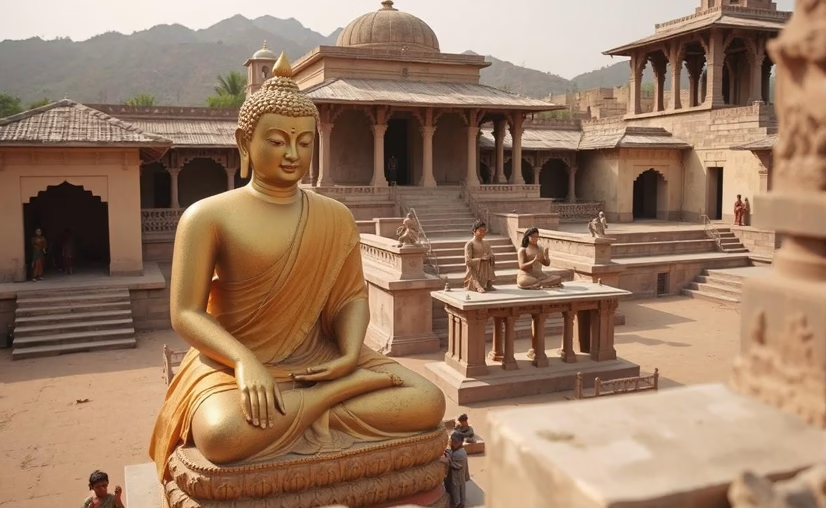Nalanda and Taxila: The Golden Age of Buddhist Education

The ancient universities of Nalanda and Taxila stood as central institutions during the golden age of Buddhist education. They nurtured wisdom, attracting global scholars.
During their existence from the 5th century BCE to the 12th century CE, Nalanda and Taxila stood as centers for Buddhist education that developed both intellectual exchange and wisdom. Scholars from throughout the Asian continent converged at these institutions which played a crucial role in developing Buddhist philosophy and enriching global knowledge. As someone who studies ancient learning centers I’m inspired by their rigorous academic programs and inclusive communities which created a lasting legacy of compassion and insight that continues to influence us today.
Taxila: The Early Center of Learning
During the 5th century BCE Taxila developed into a key educational center in present-day Pakistan for both Buddhist teachings and secular subjects. The archaeological digs at Taxila uncovered monasteries along with stupas and lecture halls which demonstrate the presence of an active scholarly community. Young scholars traveled to Taxila according to the Jataka Tales. By the 4th century BCE Taxila had accommodated thousands of students from regions such as Persia and Greece according to historian A.L. Basham.
Features of Taxila
- Diverse Curriculum: Taught Buddhist texts, medicine, astronomy, and archery.
- Monastic Life: Viharas supported meditation and scriptural study.
- Cultural Exchange: Hellenistic influences enriched art and philosophy.
Nalanda: The Pinnacle of Buddhist Scholarship
The world’s first residential university was established in modern-day Bihar, India during the 5th century CE called Nalanda. The Chinese traveler Xuanzang documented that 10,000 students and 2,000 teachers were present at the institution during his studies in the 7th century. The Dharmaganja library at Nalanda maintained a collection of millions of manuscripts. According to a 2019 study from the Journal of Buddhist Studies Nalanda played a key role in the expansion of Mahayana Buddhism across East Asia.
Nalanda’s Academic Excellence
- Rigorous Admission: Students passed oral exams to enroll.
- Broad Disciplines: Covered Pali Canon, logic, grammar, and medicine.
- Global Reach: Attracted students from China, Korea, and Tibet.
Read other related texts found within our article on Essence of Buddhist Sutras.
The Golden Age of Buddhist Education
Nalanda and Taxila reached their peak during the golden age (5th–12th centuries CE) with support from the royal Gupta and Pala dynasties. They created standardized Buddhist doctrines which resulted in texts such as the Abhidhamma. UNESCO designates the remains of Nalanda as a World Heritage Site because of its historic importance to education worldwide. According to British Museum records, Gandharan art from Taxila united Buddhist themes with Greek artistic elements.
Contributions to Knowledge
- Philosophy: Developed concepts like emptiness and dependent origination.
- Science and Medicine: Advanced astronomy and Ayurveda.
- Text Preservation: Copied Pali and Sanskrit manuscripts for posterity.
Why Nalanda and Taxila Matter Today
The historical legacy of these universities created the foundation for contemporary education systems through their focus on critical analysis and interdisciplinary learning. Their compassion-centered approach matches mindfulness practices while a 2021 Mindfulness journal study demonstrates meditation’s cognitive advantages. According to a 2022 Heritage Studies report the ancient ruins drive cultural tourism which leads to interfaith discussions.
Ways to Engage with Their Legacy
- Visit Sites: Explore Nalanda’s ruins or Taxila’s museums.
- Study Texts: Study Buddhist literature by reading Abhidhamma texts or Xuanzang’s accounts from Ancient Buddhist Texts.
- Meditation: Apply Buddhist principles in mindfulness practice.
- Support Preservation: Advocate for UNESCO conservation efforts.
Read our article about Ancient Buddhist Legacy to learn more.
FAQ: Nalanda and Taxila
- Q: What was the role of Nalanda and Taxila in ancient education?
- A: Nalanda and Taxila functioned as premier ancient universities that promoted Buddhist teachings along with other secular disciplines to students from around the world.
- Q: How did Nalanda contribute to Buddhist scholarship?
- A: The Nalanda University systematized Mahayana Buddhist teachings while educating numerous scholars and maintaining Buddhist texts that enabled Buddhism’s expansion into East Asia.
- Q: What was Taxila’s significance in early Buddhist education?
- A: Taxila played a crucial role in early Buddhist education because it offered students a diverse curriculum that combined Buddhist teachings with secular education and encouraged cultural exchange with Persia and Greece.
- Q: How do the educational methods of Nalanda and Taxila influence modern education?
- A: Universities draw inspiration from their interdisciplinary approach and focus on critical thinking while mental health benefits from their mindfulness teachings.
- Q: Which resources can I access to understand Nalanda and Taxila better?
- A: Explore UNESCO locations and use materials from Ancient Buddhist Texts along with the Buddhist Digital Resource Center to learn more.
Conclusion: The Enduring Legacy of Buddhist Education
The two pivotal Buddhist educational institutions Nalanda and Taxila cultivated wisdom and compassion during their golden age and helped shape global thought patterns. The enduring impact of these institutions encourages us to seek both knowledge and peaceful living. Comment below with your thoughts about these historic Buddhist universities or subscribe for additional Buddhist historical insights!